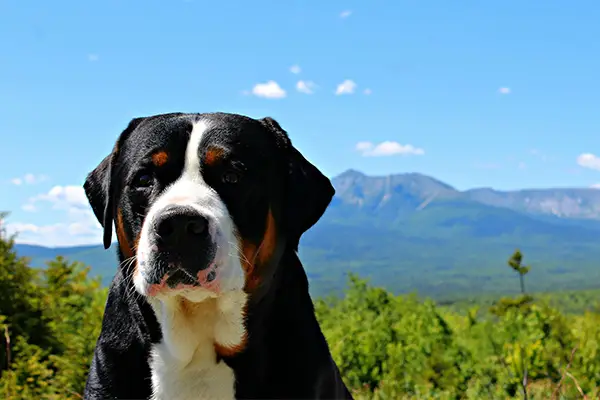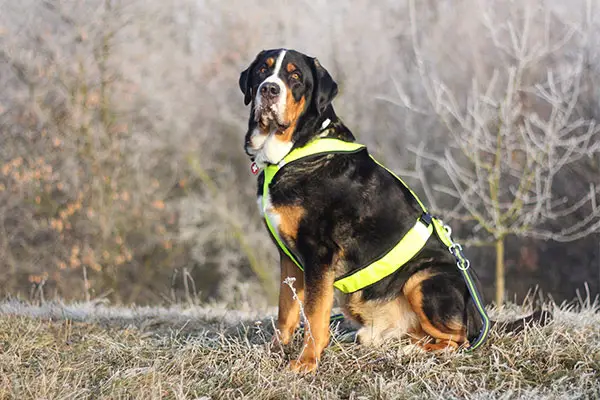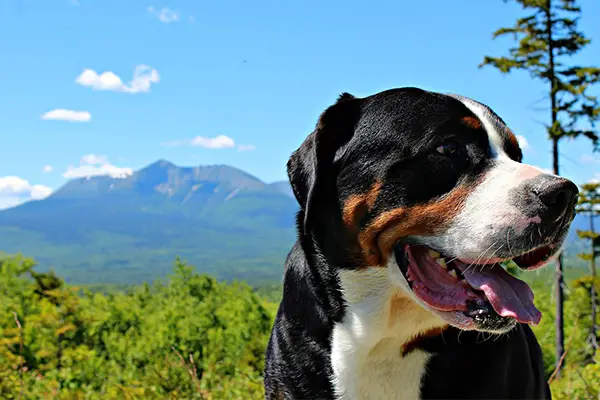The Greater Swiss Mountain Dog or Swissy is a large-sized dog originally developed as an all-around working dog. They stand at the height of 28.5 inches (maximum) and are usually covered in a beautiful tricolored coat of black, red, and white.
They are beautiful dogs that will make anybody’s head turn. However, they are not dogs for inexperienced owners. You need to be willing to shower them with enormous amounts of love and care.

Greater Swiss Mountain Dog Statistics
| Dog Breed Group | Working |
| Breed Size | Large to Giant |
| Height | 25.5-28.5 inches (male); 23.5-27 inches (female) |
| Weight | 115-140 pounds (male); 85-110 pounds (female) |
| Lifespan | 8-11 years |
Greater Swiss Mountain Dog Ratings
| Energy level | |
| Exercise needs | |
| Requires attention | |
| Playfulness | |
| Trainability | |
| Shedding | |
| Grooming | |
| Friendly with family | |
| Friendly with kids | |
| Friendly with strangers | |
| Friendly with other dogs | |
| Prey Drive |
Greater Swiss Mountain Dog History
The Greater Swiss Mountain Dog is considered to be one of the oldest breeds in Switzerland that goes back centuries ago. These dogs are believed to have descended from the Roman Mastiffs (war dogs brought over to the Alps by the army of Julius Caesar).
For centuries, these dogs served as all-around dogs – herding dogs, guard dogs, and draft dogs. And though they were considered as one of the most popular dogs in Switzerland, their numbers started to go down by the 1900s.
In 1908, Albert Heim, a canine researcher, spotted two dogs at the Swiss Kennel Club that are named short-haired Bernese Mountain Dogs. However, these dogs seem to be large members of a different dog breed. So in 1909, the dogs were recognized as a separate breed and were named Greater Swiss Mountain Dogs.
Years after, the popularity of the breed grew. By 1968, Greater Swiss Mountain Dogs were finally brought to the US. But it was only in 1995 when the American Kennel Club finally recognized the dog breed.
Temperament
The American Kennel Club describes the Swissies as faithful, family-oriented, and dependable. Even with their giant size, these dogs are excellent family companions and are never aggressive with anyone.
The Greater Swiss Mountain Dogs thrive for human companionship. Most of the time, they are willing and eager to please. When it comes to children, the Swissies are very gentle and sweet. They are also surprisingly good with other animals, even with dogs.
These dogs are alert and observant. You can expect them to bark when a newcomer comes for a visit, which makes them excellent watchdogs. However, they are quick to warm-up to them too.
It’s important to start training them at an early age. This way, you might still be able to control their instinct to chase smaller animals or kids. Training them might take patience, especially that they can be independent and stubborn.
Being consistent and firm is essential. If you are inexperienced with this, then it’s advisable to enroll your Swissy to a puppy school.
Early socialization is vital too. Introduce him to new people, dogs, sights, and sounds from time to time to get him accustomed to it. This will also help in making them more well-rounded indoor dogs.

Care Requirements
- Nutrition: Greater Swiss Mountain Dogs need to have a high-quality and well-balanced meal. It is also recommended to feed an adult Swissy at least 2685 kcal of food daily. Those that are older might require less of this, especially if they are not also very active dogs. The Greater Swiss Mountain Dog doesn’t have a particular diet it needs to follow. They will do well, whether it’s dog food or a home-cooked meal. The only thing you need to keep in mind is that the food must contain high-quality ingredients. The food should contain a high percentage of protein. It must also include some fats, carbohydrates, vitamins, and minerals. For proteins, it’s highly recommended to serve these dogs animal protein. As for the fats, fish and chicken oils are excellent sources. You can add some vegetables and fruits too to improve your dog’s digestion. For dog food, only choose the premium ones. Read the labels and make sure that it does not contain any fillers or additives that will be harmful to your dog’s health.
- Grooming: The Greater Swiss Mountain Dog has a wash-and-wear type of coat. It is known to be double-coated and sheds seasonally. Weekly brushing is highly recommended for these dogs. But when the shedding season comes, it’s nice to brush their coat daily or a couple of times a week. Occasional baths are recommended. Usually, this can be once every few months. But, ears should be cleaned regularly to avoid ear infections from happening. Nails should be checked and trimmed regularly. It should not be kept long, as this will cause pain and discomfort to your dogs.
- Exercise: The Greater Swiss Mountain Dog requires regular but moderate exercise. This is important to keep their bones healthy. An hour of daily walking will usually suffice for these dogs. If you love outdoor activities, then you can surely take them out for a hike. You can even have them as biking and running companions.
- Health: The Swissies generally have a long lifespan, especially if kept healthy. This is why it’s best to know which diseases affect this dog breed frequently. A few minor problems to look out for are distichiasis, panosteitis, shoulder osteochondrosis dissecans, gastric torsion, seizures, splenic torsion, and female urinary incontinence. One major health issue is canine hip dysplasia, which is very common in dog breeds of this size. You have your dog take some screening tests so you can rule out some of the diseases above. Meeting at least one of your pups’ parents is highly recommended, so you know what genetic health conditions to watch out for.
- Lifespan: The life expectancy of Greater Swiss Mountain Dogs is 8-11 years.

Fun Facts about Greater Swiss Mountain Dogs
- Greater Swiss Mountain Dogs originated in Switzerland centuries ago.
- They are believed to have come from the same line of the Roman Molossian and Mastiff dogs.
- They were originally called “Metzgerhund” or butcher’s dogs.
- Their coat comes in three colors – black, white, and copper.
- They were originally bred to be all-around working dogs.
- They are built to withstand cold weather in the Alps.
- The dogs almost came into extinction in the 1900s.
- The dogs were imported to the US by 1968.
- They were only officially recognized by the American Kennel Club in 1995.
- They are considered to be a rare breed.
